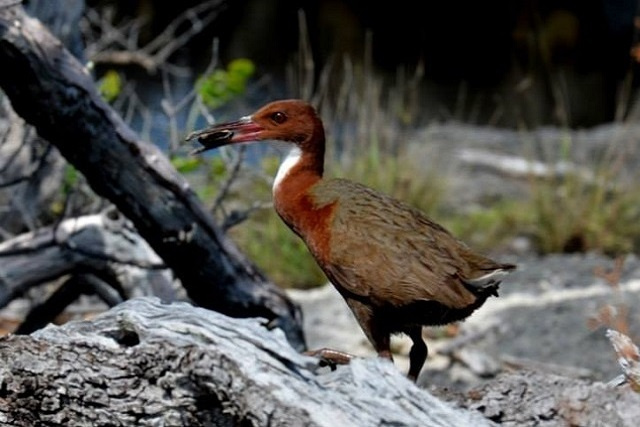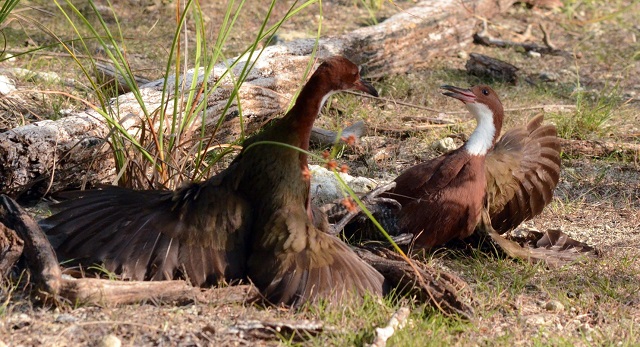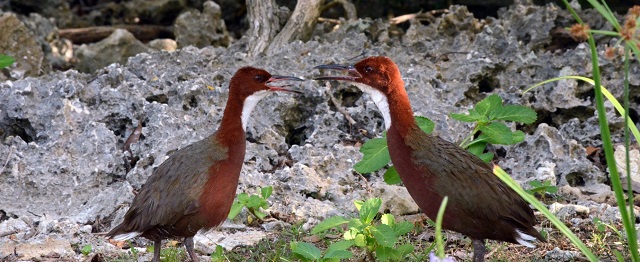New research finds that flightless bird in Seychelles should be own species
Victoria, Seychelles | March 9, 2020, Monday @ 10:55 in Environment » SPECIES | By: Daniel Laurence Edited by: Sharon Ernesta | Views: 208911

The white-throated rail (Dryolimnas Cuvier) or Cuvier's rail is a species of bird in the family Rallidae. It is found in Comoros, Madagascar, Mayotte, and Seychelles. (Seychelles Islands Foundation)
A new research paper published recently on Seychelles' endemic white-throated rail has shown that through evolution the species has lost its ability to fly.
The bird, found only on the remote atoll Aldabra, is being considered as one of the fastest examples of the evolution of loss of flight in birds to be documented.
The paper is recommending that the white-throated rail is considered an evolutionary distinct species, not a subspecies as previously thought.
The white-throated rail (Dryolimnas Cuvier) or Cuvier's rail is a species of bird in the family Rallidae. It is found in Comoros, Madagascar, Mayotte, and Seychelles.
The parent species of the rail, indigenous to Madagascar, would frequently see its population explode, forcing the birds to migrate in great numbers from the island off the coast of East Africa, including Aldabra.
 |
| It is believed that the rails on Aldabra lost the ability to fly over time, because of the lack of predators made it unnecessary (Seychelles Islands Foundation) Photo License: CC-BY |
“The Aldabra rail is the last flightless bird species in the Western Indian and as such holds a very special place in the avifauna of the region and of Seychelles," the Director of Research and Conservation, Nancy Bunbury, told SNA.
Bunbury explained that prior to this research the Aldabra rail was considered a subspecies of the common Madagascar white-throated rail, which can fly.
"It was an obvious research avenue to look into the genetics and morphology of the Aldabra rail to determine whether the differences are also at the genetic level and in the anatomy of the birds,” said the researcher.
It is believed that the rails on Aldabra lost the ability to fly overtime, because of the lack of predators made it unnecessary, just as the dodo of Mauritius did.
Unfortunately for the dodo, that gave them no means of escape when the island was submerged and all its flora and fauna were wiped out.
Aldabra is the world's second-largest coral atoll. It is situated in the Aldabra Group of islands that are part of the Outer Islands of the Seychelles — 115 islands in the western Indian Ocean.
“We have long felt that the flightless Aldabra rail being categorized as subspecies of a species which is fully volant and very widely distributed in Madagascar — and therefore of little conservation concern — didn't quite make sense and wasn't helping the conservation of the Aldabra rail,” added Bunbury.
Upon their research, researchers from the Seychelles Islands Foundation and collaborators analyzed modern samples and historical (museum) specimens to examine the genetics and morphology of the flightless rails. The museum specimens were needed to obtain the DNA from the extinct rails from Assumption.
 |
| A new research paper published on Seychelles' endemic white-throated rail has shown that through evolution the species has lost its ability to fly. (Seychelles Islands Foundation) Photo License: CC-BY |
“With the current, worrying, loss of species worldwide, it is vital to understand how key traits with which organisms can adapt to certain niches or ecosystems can evolve, and the speed with which such evolutionary processes can occur," said the researcher.
According to Bunbury "the uniqueness of an organism and its vulnerability to extinction is not recognized, it may not receive the appropriate conservation management that is needed to prevent it from going extinct.”
The researchers provided recommendations to the International Union for Conservation of Nature (IUCN) to re-assess the Red List (threat) status of the Aldabra White-Throated Rail.
“As the last flightless bird in the Western Indian Ocean, the Aldabra rail has long had unique conservation significance, and this paper confirms and increases its importance. It is crucial that this unique endemic species receive appropriate recognition, protection and conservation management," concluded Bunbury.





